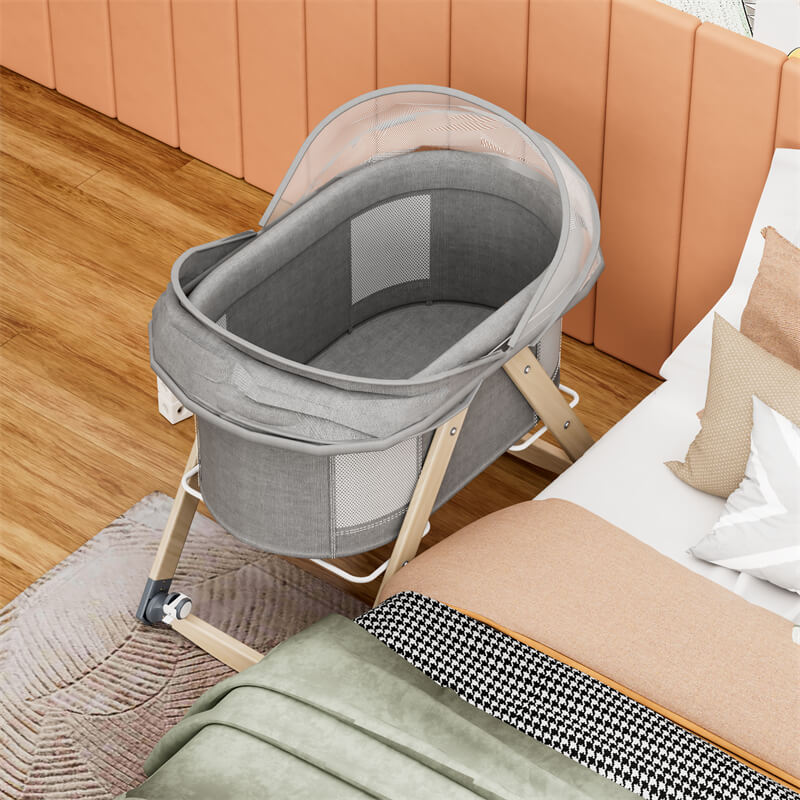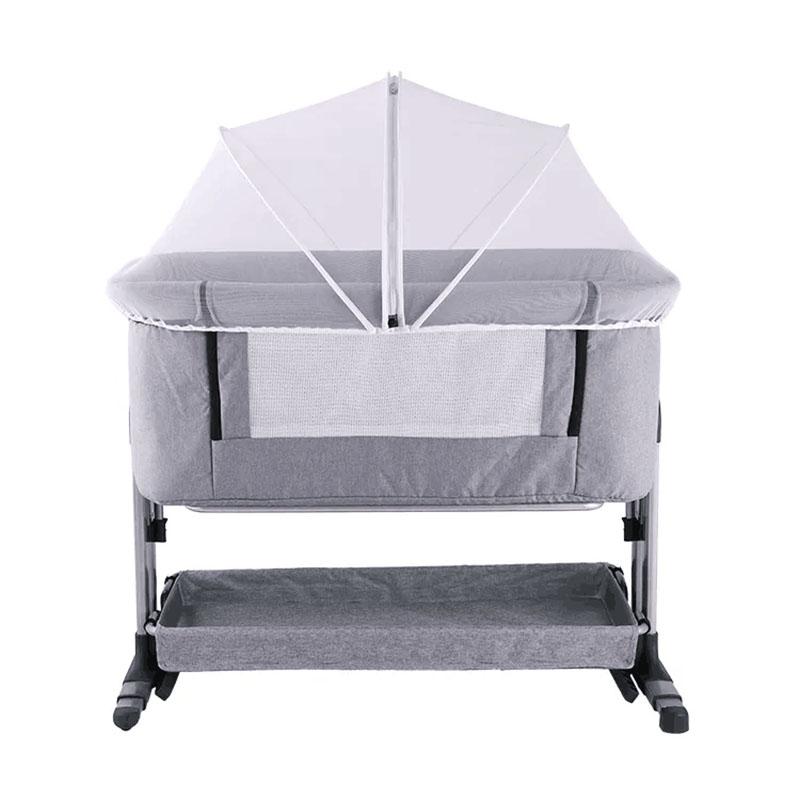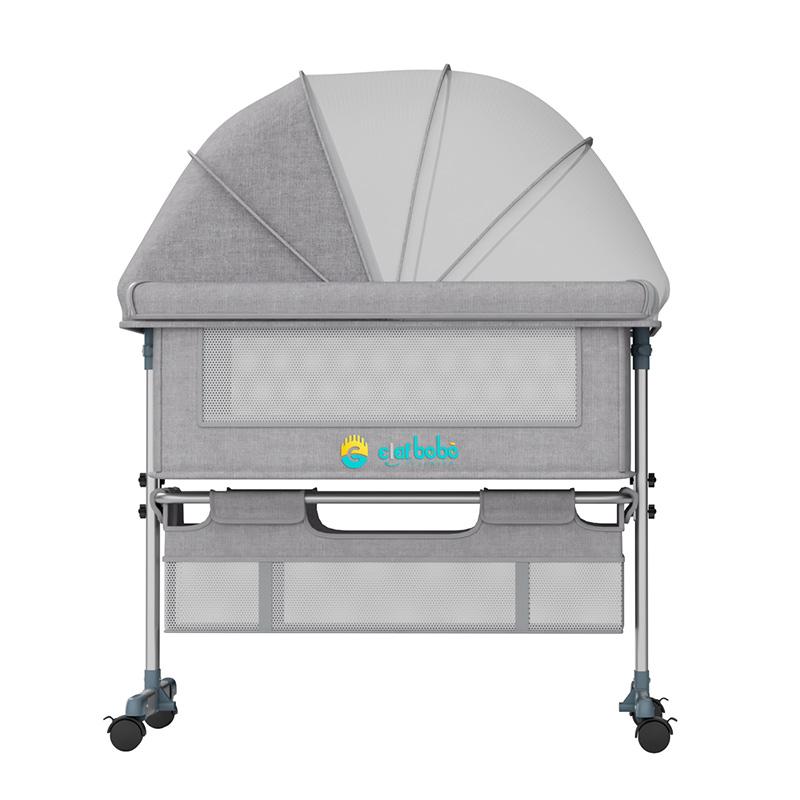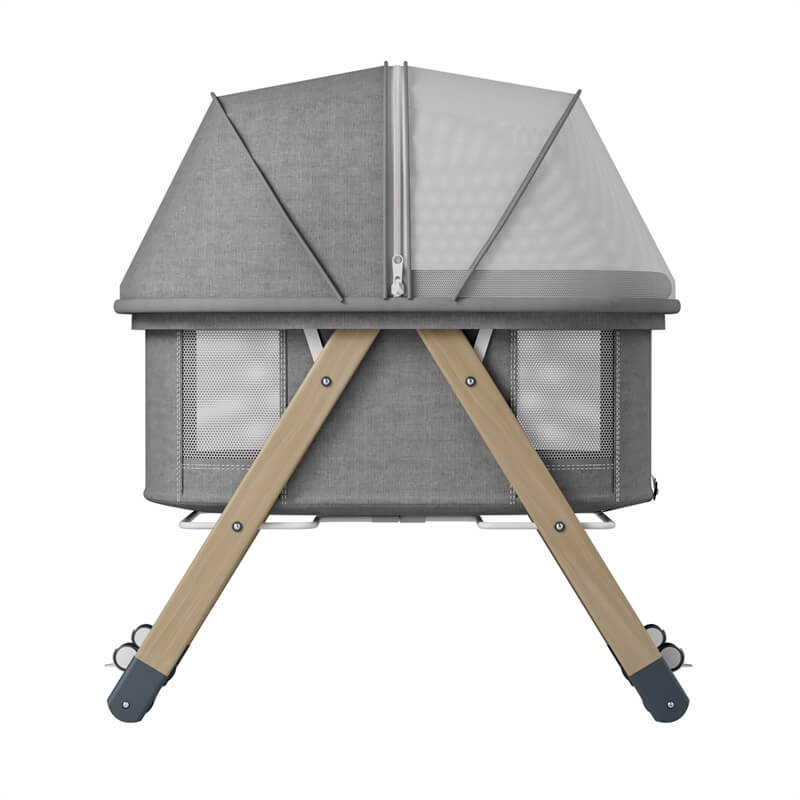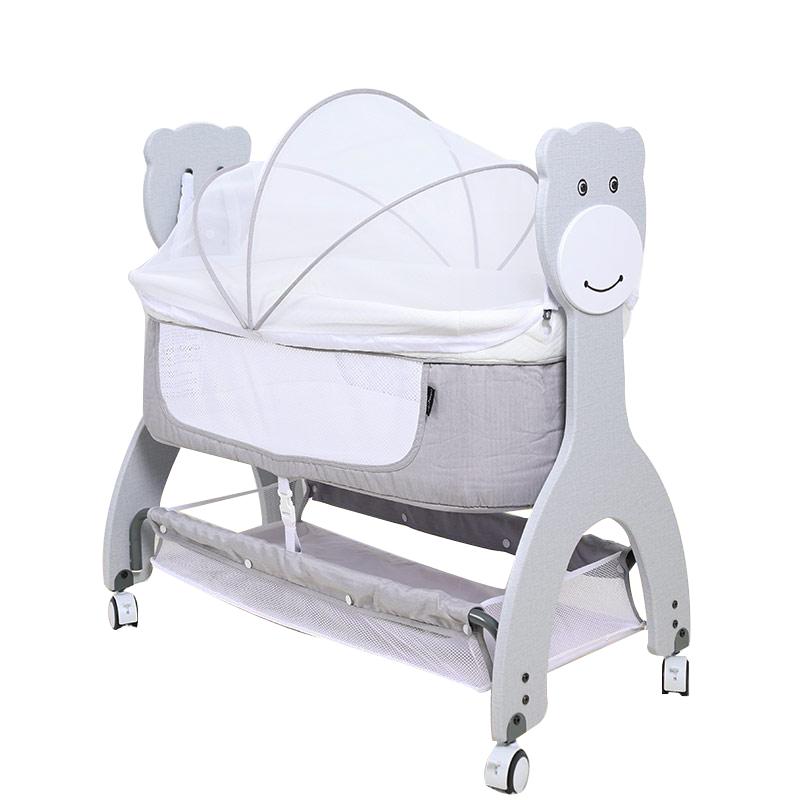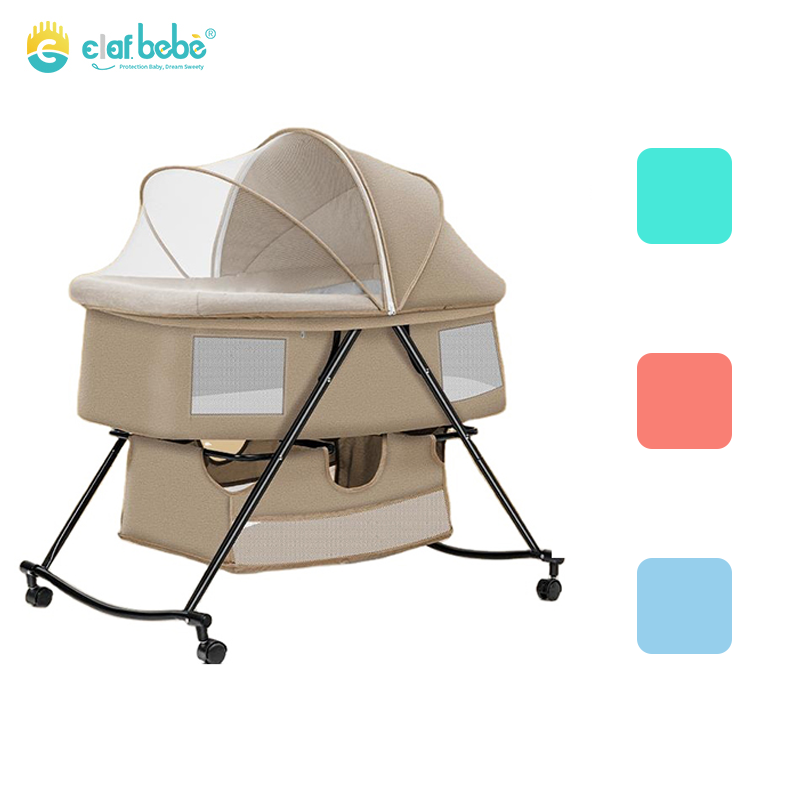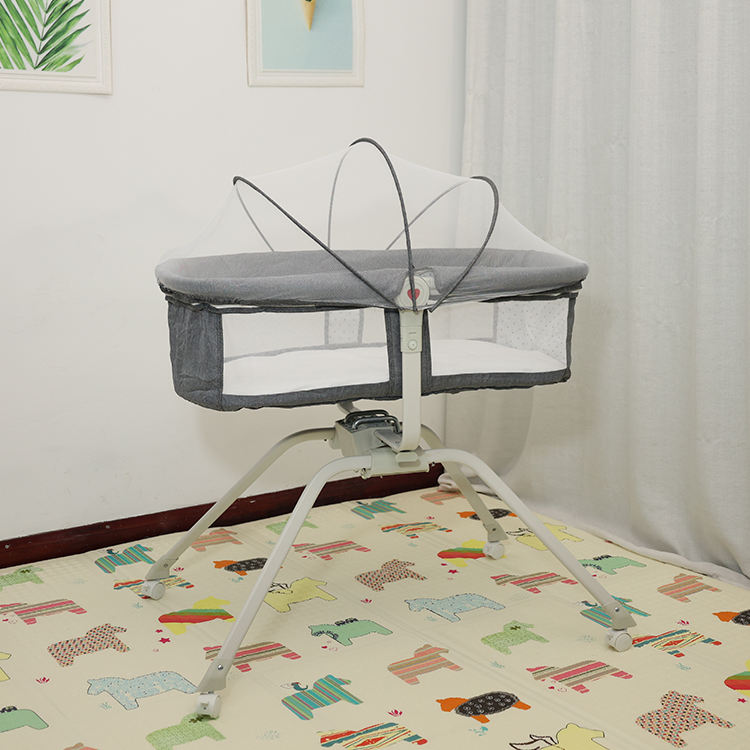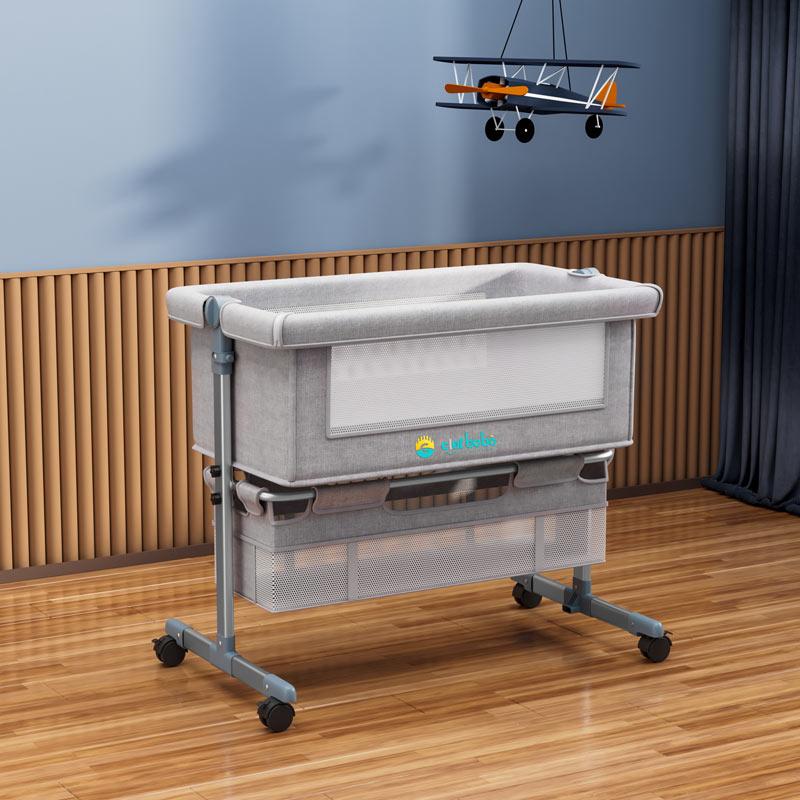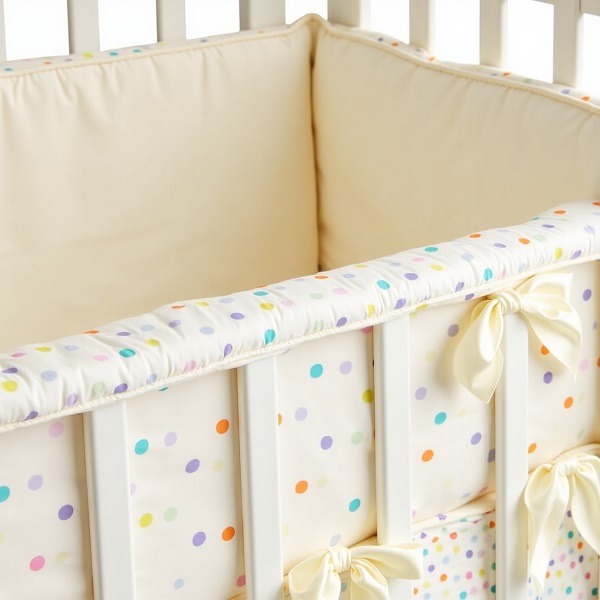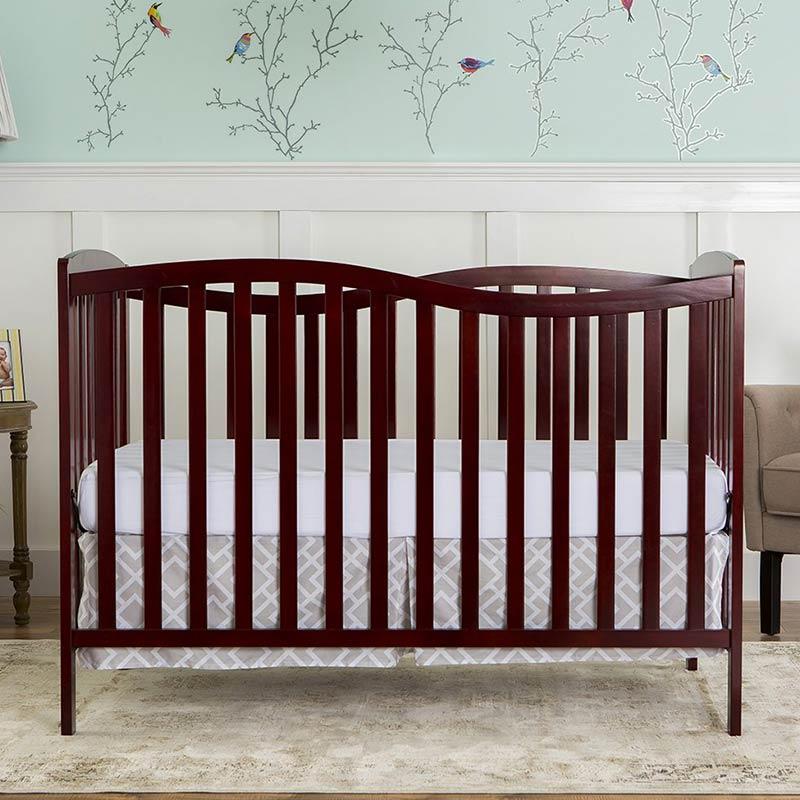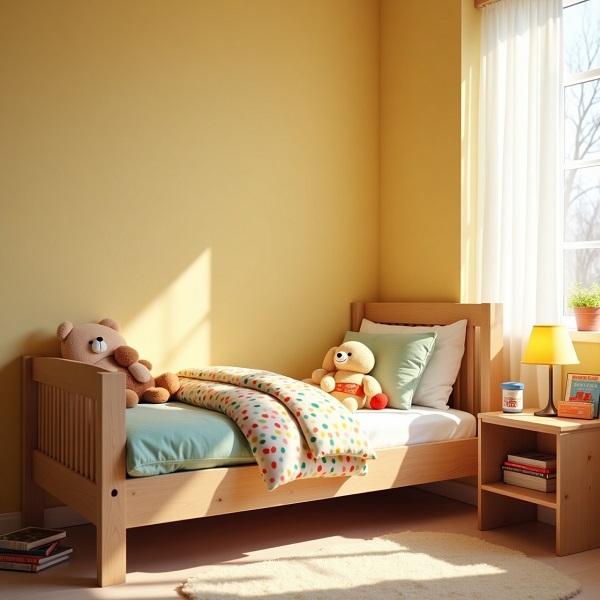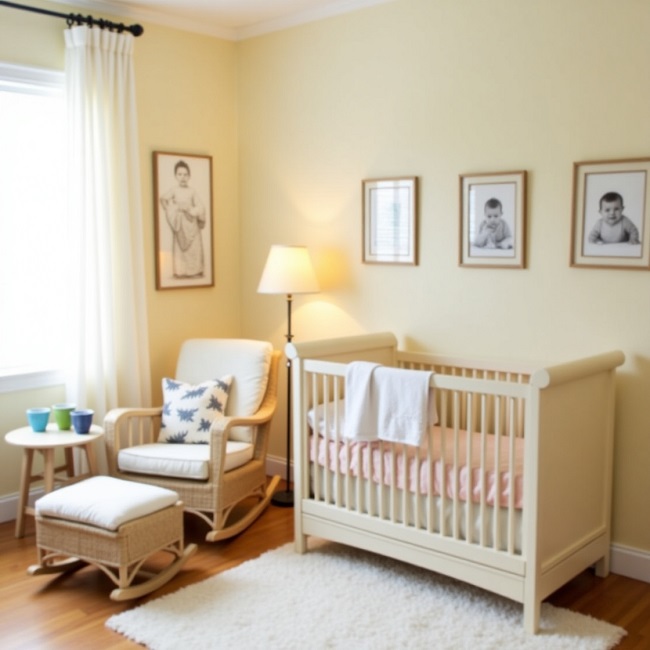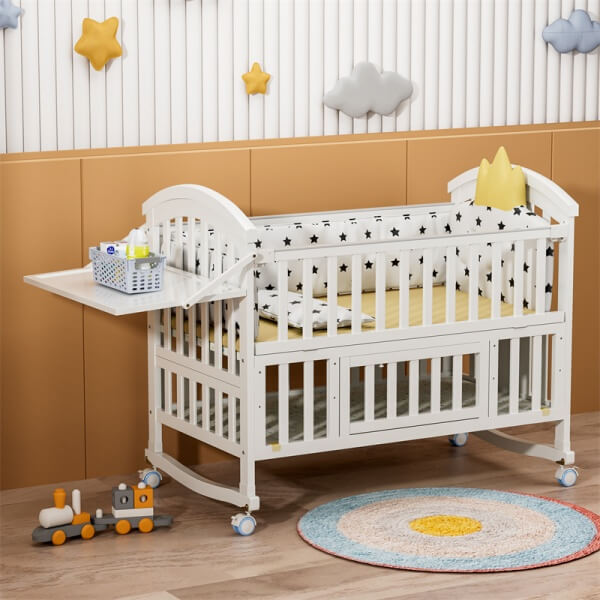Having a baby is a joyful and exciting time, but it also comes with its fair share of challenges, especially when it comes to getting a good night’s sleep. One solution that many parents have found helpful is using a co-sleeper bassinet attached to their bed.
This innovative sleeping arrangement allows your baby to be close to you while still having their own safe space. In this guide, we’ll explore the ins and outs of co-sleeper bassinets and how to choose the right co-sleeping bassinet for your baby.
What Is a Co-Sleeper Bassinet?
A co-sleeper bassinet is a specialized sleeping arrangement designed to allow a newborn or infant to sleep near their parents while still having their own separate sleeping space. Co-sleeper bassinets often resemble traditional baby cradles but are specifically designed to attach securely to the side of the parent’s bed.
They typically have a rectangular or oval-shaped frame with mesh or fabric sides for breathability and visibility. The height of the baby cradle is usually adjustable to align with the height of the parent’s mattress, ensuring a seamless transition between the two surfaces.
What Are the Benefits of a Co-Sleeper Bassinet?
1. Convenience for Nighttime Care
Co-sleeper bassinets make nighttime care tasks, such as feeding, soothing, and diaper changes, more convenient for parents. Instead of having to get out of bed and walk to another room, parents can attend to their baby’s needs without leaving their own bed, minimizing sleep disruption.
2. Improved Sleep Patterns
Research published in the journal Pediatrics suggests that room-sharing without bed-sharing, such as using a co-sleeper bassinet, is associated with a reduced risk of Sudden Infant Death Syndrome (SIDS) by as much as 50%. This finding underscores the importance of having the baby sleep near the parents while maintaining a separate sleeping space.
Data from a study conducted by the American Academy of Pediatrics (AAP) indicates that infants who room-share with their parents but sleep in their own sleep surface, such as a co-sleeper bassinet, tend to have longer sleep durations and fewer nighttime awakenings compared to those who sleep in a separate room.
3. Enhanced Breastfeeding Success
According to a systematic review published in the Journal of Human Lactation, room-sharing with the baby, especially in the early postnatal period, has been linked to increased breastfeeding duration and exclusivity. Co-sleeper bassinets facilitate frequent breastfeeding by allowing easy access to the baby during nighttime feedings, which is crucial for establishing and maintaining milk supply.
4. Strengthened Parent-Child Bonding
Co-sleeping promotes a responsive parenting style, where parents can quickly respond to their baby’s cues and needs throughout the night. Mothers who room-shared with their infants reported feeling more connected to their babies and more confident in their parenting abilities compared to mothers who slept separately from their infants.
5. Increased Sense of Security and Comfort
Data from the National Sleep Foundation suggests that feeling safe and secure during sleep is essential for optimal rest and overall well-being. Infant bedside bassinets create a sense of security for both the baby and the parents, leading to more restful sleep and a happier, healthier family dynamic.
The close proximity of the baby provides parents with peace of mind, knowing that they can quickly attend to their baby’s needs without having to leave their bed.
How to Build Co Sleeper Bassinet
Building and setting up a co-sleeper bassinet involves several steps to ensure safety and stability. Here’s a comprehensive step-by-step guide:
Step 1: Gather Your Materials:
- Co-sleeper bassinet kit
- Screws and bolts (typically included with the kit)
- Screwdriver or drill
- Measuring tape
- Level
Step 2: Choose the Location:
Decide where you want to place the rocker cradle next to your bed. Ensure there is enough space for both the bassinet and your movement around the bed.
Step 3: Adjust the Height:
Measure the height of your mattress and adjust the co-sleeper bassinet to match it. Most bassinets have adjustable legs or height settings to align with different mattress heights.
Step 4: Attach the Straps or Hooks:
Securely attach the straps or hooks provided with the co-sleeper bassinet to the frame. These will be used to anchor the bassinet to the parent’s bed.
Step 5: Position the Bassinet:
Place the co-sleeper bassinet next to your bed with the open side facing towards your mattress. Ensure that it is aligned properly and centered with your bed.
Step 6: Secure the Bassinet to the Bed:
Use the straps or hooks to attach the co-sleeper bassinet securely to the side of your bed. Wrap the straps around the bed frame or hook them onto the bedrail, depending on the design of your bassinet.
Step 7: Check for Stability:
Once the bassinet is attached, ensure that it is stable and securely anchored to the bed. Shake the bassinet gently to check for any wobbling or instability. If needed, adjust the straps or tighten the screws to improve stability.
Step 8: Test Accessibility:
Test the accessibility of the co-sleeper bassinet from your bed. Make sure you can easily reach into the bassinet to attend to your baby without straining or stretching.
Step 9: Add Bedding and Accessories:
Place a fitted sheet on the bassinet mattress to provide a comfortable sleeping surface for your baby. Avoid using loose bedding, pillows, or stuffed animals in the bassinet, as they pose suffocation hazards.
Step 10: Final Checks:
Double-check all connections and ensure that the bassinet is securely attached to the bed. Verify that there are no sharp edges or protruding parts that could pose a safety risk to your baby.
Step 11: Test Before Use:
Before placing your baby in the co-sleeper bassinet, test the setup by gently pressing down on the bassinet to simulate your baby’s movements. Ensure that the bassinet remains stable and securely attached to the bed.
Co-Sleeping Guidelines and Safety Precautions
Co-sleeping, including the use of co-sleeper bassinets, can be a safe and beneficial practice when done correctly. Here’s a comprehensive overview of safe co-sleeping practices and precautions:
1. Choose a Safe Sleeping Surface:
- Use a firm mattress that fits snugly inside the infant rocking cradle. Ensure there are no gaps between the mattress and the sides of the bassinet where the baby’s head could become trapped.
- Avoid soft bedding, pillows, blankets, or stuffed animals in the cradle, as they pose a suffocation hazard to infants.
2. Position the Baby Safely:
- Always place the baby on their back to sleep, both for naps and nighttime sleep.
- Ensure that the baby’s face is clear of any obstructions, such as blankets or pillows, to maintain an open airway.
- Do not place the baby on their side or stomach to sleep, as this increases the risk of Sudden Infant Death Syndrome (SIDS).
3. Maintain a Safe Sleep Environment:
- Keep the room at a comfortable temperature for the baby, between 68-72 degrees Fahrenheit (20-22 degrees Celsius), to prevent overheating.
- Ensure adequate airflow around the bassinet by avoiding heavy drapes, blankets, or other obstructions that could impede ventilation.
- Remove any cords or strings near the bassinet that could pose a strangulation risk to the baby.
4. Supervise the Baby’s Sleep:
- Always supervise the baby while they are sleeping in the co-sleeper bassinet, especially during the newborn stage.
- Be vigilant for signs of discomfort, overheating, or breathing difficulties, and respond promptly to the baby’s needs.
5. Avoid Alcohol and Drug Use:
- Never co-sleep with your baby if you have consumed alcohol, drugs, or medications that could impair your ability to wake and respond to your baby’s needs.
- Alcohol and drug use increases the risk of accidental suffocation or overlaying the baby while sleeping.
6. Be Mindful of Other Family Members:
- Ensure that other family members, such as siblings or pets, do not share the sleeping surface with the baby. This helps minimize the chances of unintentional suffocation or harm.
- Educate older children about the importance of respecting the baby’s sleep space and avoiding rough play near the bassinet.
Tips for Nursing and Nighttime Feeding
Before bedtime, ensure that all feeding essentials are within easy reach of the newborn baby’s cradle. This includes breast pads, nipple cream (if breastfeeding), burp cloths, bottles, formula (if bottle-feeding), and a water bottle for hydration.
The side-lying position can be particularly comfortable and convenient for breastfeeding while lying in bed. Lie on your side facing the baby, and bring the baby close to your breast. Support your breast with one hand if needed, and use your other arm to support the baby’s head and body. Nursing pillows or supports can provide additional comfort and stability during nighttime feedings. Place the nursing pillow around your waist or under your arm to elevate the baby to breast level, reducing strain on your arms and shoulders.
Establishing a consistent nighttime feeding routine can help signal to the baby that it’s time to feed and then go back to sleep. Include activities such as dimming the lights, changing the baby’s diaper, and breastfeeding or bottle-feeding in the co-sleeper bassinet.
If bottle-feeding, alternate nighttime feeding responsibilities with your partner or another caregiver. This can provide opportunities for shared bonding experiences and ensure that both parents are involved in the nighttime care routine.
After feeding, place the baby back in the safe bassinet in the recommended safe sleeping position (on their back) to reduce the risk of Sudden Infant Death Syndrome (SIDS) and ensure optimal safety during sleep.
Co-Sleeper Bassinet Accessories Recommend
Waterproof Mattress Protector: A waterproof mattress protector helps protect the infant cradle mattress from spills, leaks, and accidents.
Fitted Sheets: Fitted sheets designed for newborn cradles provide a snug and secure fit, ensuring a comfortable sleeping surface for your baby. Opt for soft, breathable fabrics such as cotton to promote airflow and regulate temperature.
Bedside Organizer: A bedside organizer attaches to the side of the co-sleeper bassinet or the parent’s bed, providing convenient storage for essentials such as diapers, wipes, pacifiers, and burp cloths.
Swivel Bed Attachment: A swivel bed attachment allows for easy access to the baby from multiple angles, making it convenient for parents to attend to their baby’s needs without having to get out of bed fully.
Canopy or Mosquito Net: Depending on your environment and preferences, a canopy or mosquito net attachment can provide added protection and comfort for your baby while they sleep. These accessories help shield the baby from harsh light, drafts, or insects, creating a cozy and secure sleeping environment.
Sound Machine or White Noise Generator: A sound machine or white noise generator can help drown out ambient noise and create a soothing background sound that promotes relaxation and better sleep for your baby. Choose a device with adjustable volume and sound options to customize the sleep environment according to your baby’s preferences.
Reclining Wedge Insert: A reclining wedge insert can be placed under the bassinet mattress to provide a slight elevation, which may be beneficial for babies with reflux or congestion.
Explore Differences: Room-Sharing Vs. Bed-Sharing
Room-Sharing (Using a Co-Sleeper Bassinet): In room-sharing, the baby sleeps in a separate sleeping space within the parent’s bedroom, such as a co-sleeper bassinet attached to the parent’s bed.
Bed-Sharing (Baby Sleeping in the Parent’s Bed): In bed-sharing, the baby sleeps in the same bed as the parents, often without any barriers between them.
Many experts recommend against sleeping in the same bed as a baby and encourage parents to use a co-sleeping bassinet or bedside crib. This is advice based on relevant research and data, focusing on reducing the risk of accidents while babies sleep.
Bed-sharing has been identified as a risk factor for Sudden Infant Death Syndrome (SIDS), which is the sudden and unexplained death of an otherwise healthy infant, typically during sleep. The presence of additional bedding, soft surfaces, and potential hazards in the adult bed can increase the risk of suffocation, overheating, or airway obstruction, contributing to SIDS.
Additionally, parents may unintentionally roll onto the baby during sleep, posing a significant risk of suffocation and positional asphyxia. Adults may not be fully aware of their movements while asleep, increasing the likelihood of accidental overlays and endangering the baby’s safety.
Co-sleeper bassinets are designed to meet safety standards for infant sleep environments, with firm, flat surfaces, breathable mesh or fabric sides, and secure attachments to the parents’ bed. These features help create a safe sleep environment for the baby while reducing the risk of accidental injury or suffocation that may occur in an adult bed.
8 Best Picks of Co-Sleeper Bassinets
When selecting a co-sleeper bassinet, it’s essential to consider factors such as safety, comfort, convenience, and functionality. Clafbebe is a well-known baby cradle manufacturer, providing high-quality wholesale and customized bassinet. Here are eight of Clafbebe’s top-rated co-sleeper bassinets, each with unique features to meet the needs of different families:
Best Bassinet for Small Space: Small Co-Sleeper Bassinet
When space is limited, finding a compact yet functional co-sleeper bassinet becomes crucial. The bassinet’s compact footprint and slim profile make it suitable for narrow spaces or tight quarters, such as small bedrooms or shared living spaces. Adjustable height settings ensure compatibility with various bed heights, accommodating different mattress thicknesses without sacrificing safety.
Best Bassinet for Newborns: Co-Sleeper Bassinets with Nursing Table
Designed specifically for newborns, this bassinet adds convenience and eases the work of nursing them. The bassinet can be integrated with a nursing table that attaches to the side of the bassinet, providing a convenient surface for diaper changes, nighttime feedings, and other nursing tasks.
Instead of having to get out of bed and navigate to a separate changing area, parents can simply reach over to the attached nursing table, minimizing disruptions to both their sleep and the baby’s sleep. This ease of access encourages more frequent and timely feedings, which is essential for newborns’ growth and development.
Best Travel Bassinet: Foldable Bassinet
This travel bassinet features a convenient foldable design that makes it easy to transport and store when not in use. It collapses flat with a simple folding mechanism, allowing for hassle-free packing and carrying during travel.
It provides a comfortable and secure sleep environment for infants with a padded mattress and a protective canopy that shields the baby from sun, insects, and other elements when used outdoors.
The bassinet’s lightweight construction and compact size make it ideal for travel, whether for family vacations, visits to relatives, or outings to the park.
The Most Versatile Bassinet: 3 in 1 Convertible Bassinet
This versatile bassinet offers three modes: bassinets, co-sleepers, and playards, providing multiple functions in one convenient package.
The bassinet mode provides a cozy and safe sleeping space for newborns, with breathable mesh sides and a comfortable mattress pad.
The proximity of the baby in the co-sleeper mode promotes responsive caregiving and supports breastfeeding, fostering a strong attachment between parent and infant.
The playard mode serves as a secure and spacious play area for infants and toddlers, with a removable bassinet and a full-size playpen for extended use.
Safest Bassinet: Non-toxic Bassinet with Stable Construction
Made from LVL (laminated veneer wood) and cotton, this bassinet is known for its durability and stability, ensuring a safe sleeping environment for babies.
It features a non-toxic finish that is free from harmful chemicals such as lead, phthalates, and formaldehyde, providing peace of mind for parents concerned about their baby’s exposure to toxins.
The bassinet’s sturdy construction and wide base offer stability and support, minimizing the risk of tipping or rocking during use. Its stable construction, non-toxic finish, and adherence to safety standards make it the ideal choice for parents seeking the safest bassinet for their baby.
Best Smart Bassinet: Electric Rocking Bassinet
The Bassinet is equipped with advanced technology that responds to your baby’s cries with gentle rocking motions and white noise to soothe them back to sleep.
The bassinet offers different levels of soothing, ranging from gentle rocking for fussiness to more vigorous rocking for persistent crying, adjusting to the baby’s needs throughout the night. Its safety features, customizable settings, and monitoring capabilities make it the best choice for parents seeking a smart bassinet that promotes better sleep for their baby and themselves.
Best Portable Bassinet: Bassinet with Wheels
This portable bassinet features four swivel wheels, allowing for easy maneuverability and transport between rooms. The bassinet’s compact and lightweight design makes it ideal for travel or moving between different areas of the home.
The bassinet’s adjustable height settings allow it to align with various bed heights, making it suitable for bedside use or standalone placement. It features a storage basket underneath the bassinet, providing convenient storage space for essentials such as diapers, wipes, and blankets.
Best Affordable Bassinet: High-Quality Simple Bassinet
The bassinet offers a high-quality yet simple design at an affordable price point. It provides comfortable sleeping space for newborns with a firm and supportive mattress pad and breathable mesh sides for airflow. It meets or exceeds safety standards for bassinets, ensuring a secure sleep environment for infants. The bassinet offers excellent value for budget-conscious parents without compromising on quality or safety.
Conclusion
In conclusion, a co-sleeper bassinet attached to the parent’s bed can be a practical and safe solution for nighttime sleep and feeding. It offers numerous benefits, including convenience, increased bonding opportunities, and improved sleep quality for both parents and babies.
By following safety guidelines, building a co-sleeper bassinet, and choosing the right accessories and sleeping arrangements, you can create a nurturing environment that promotes a restful night’s sleep for the entire family.
Recommended Related Articles:

